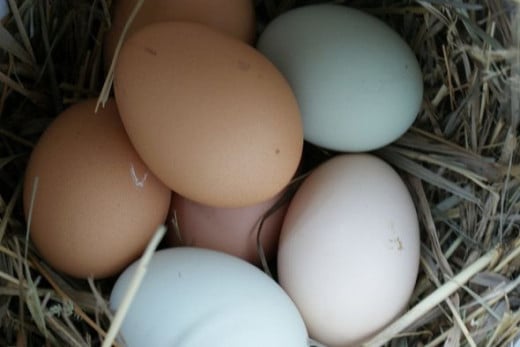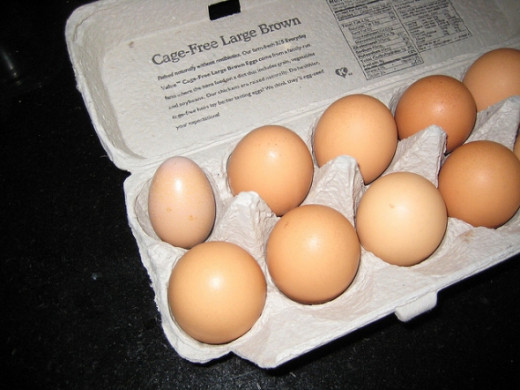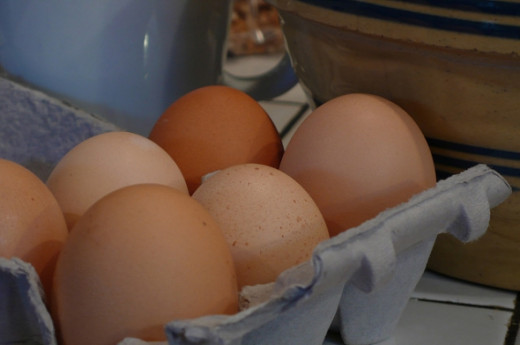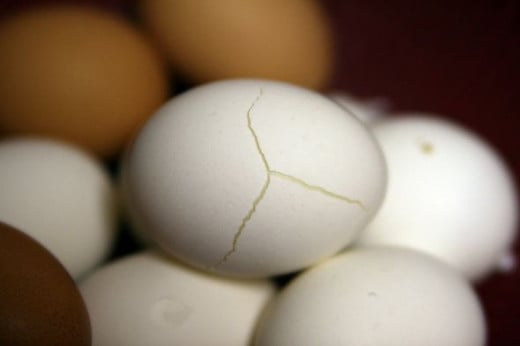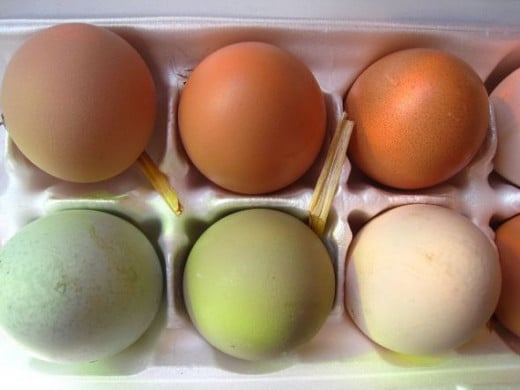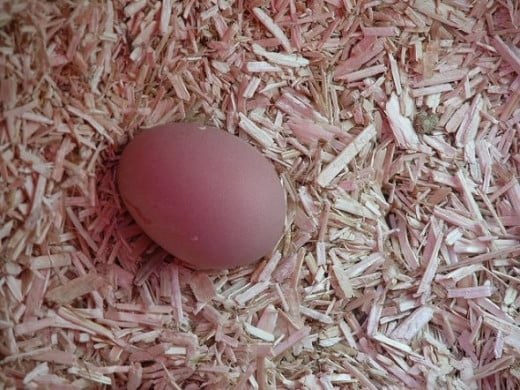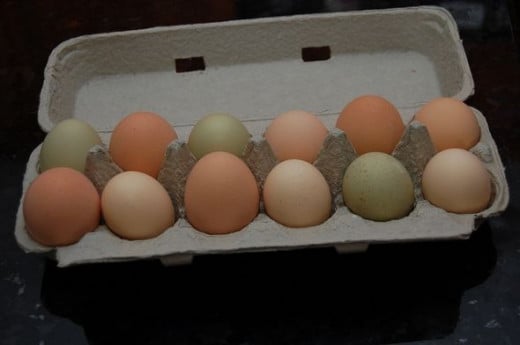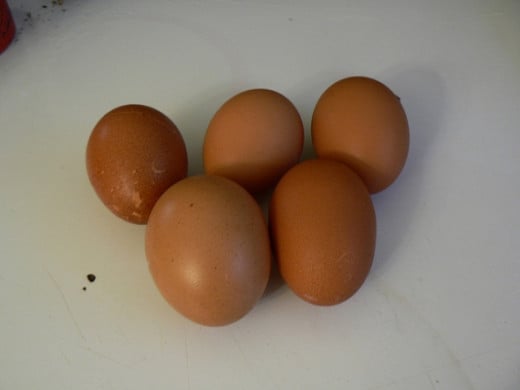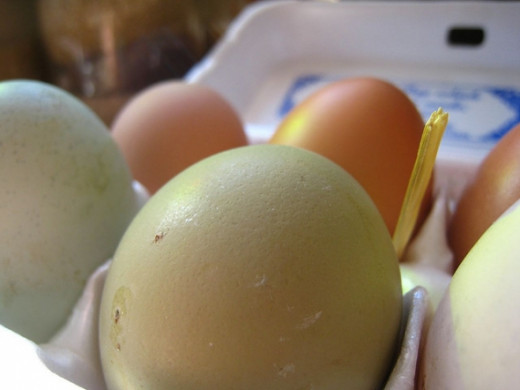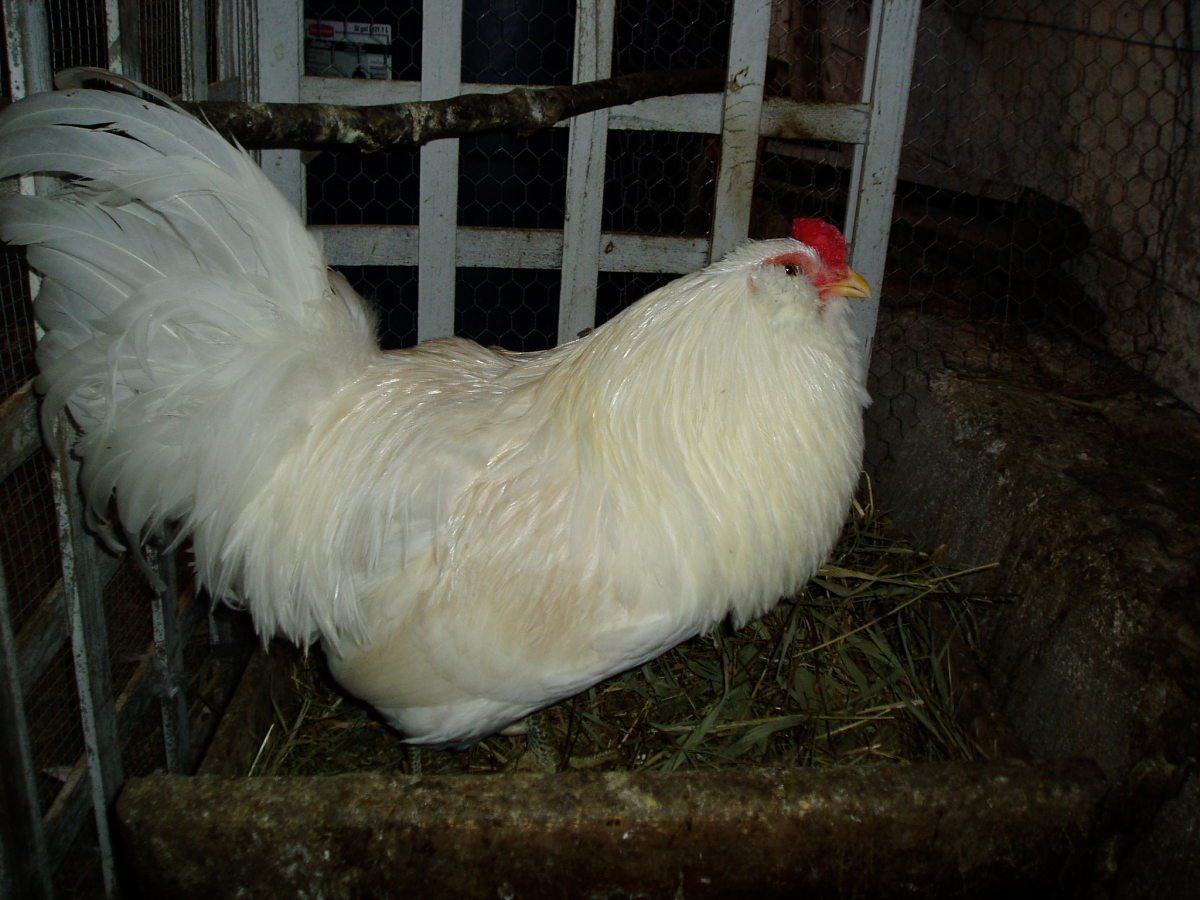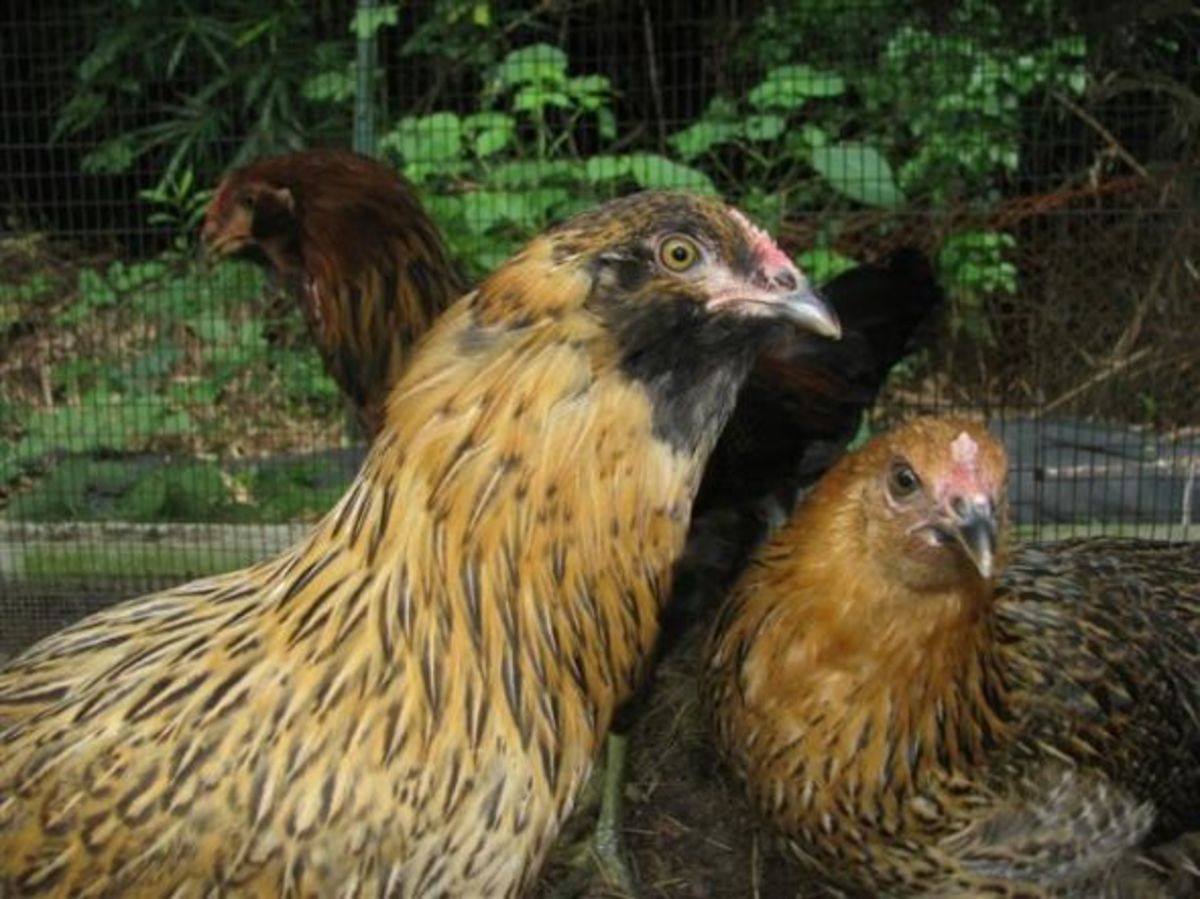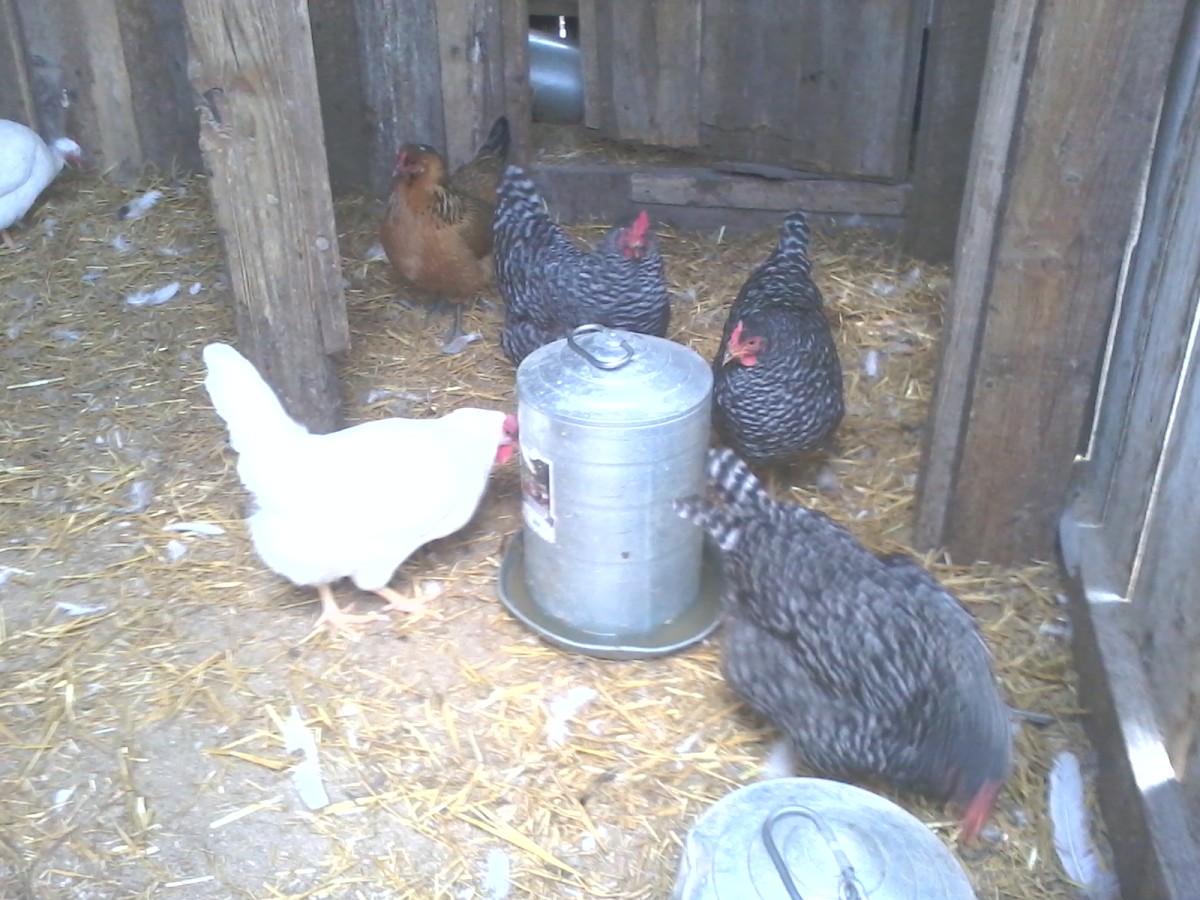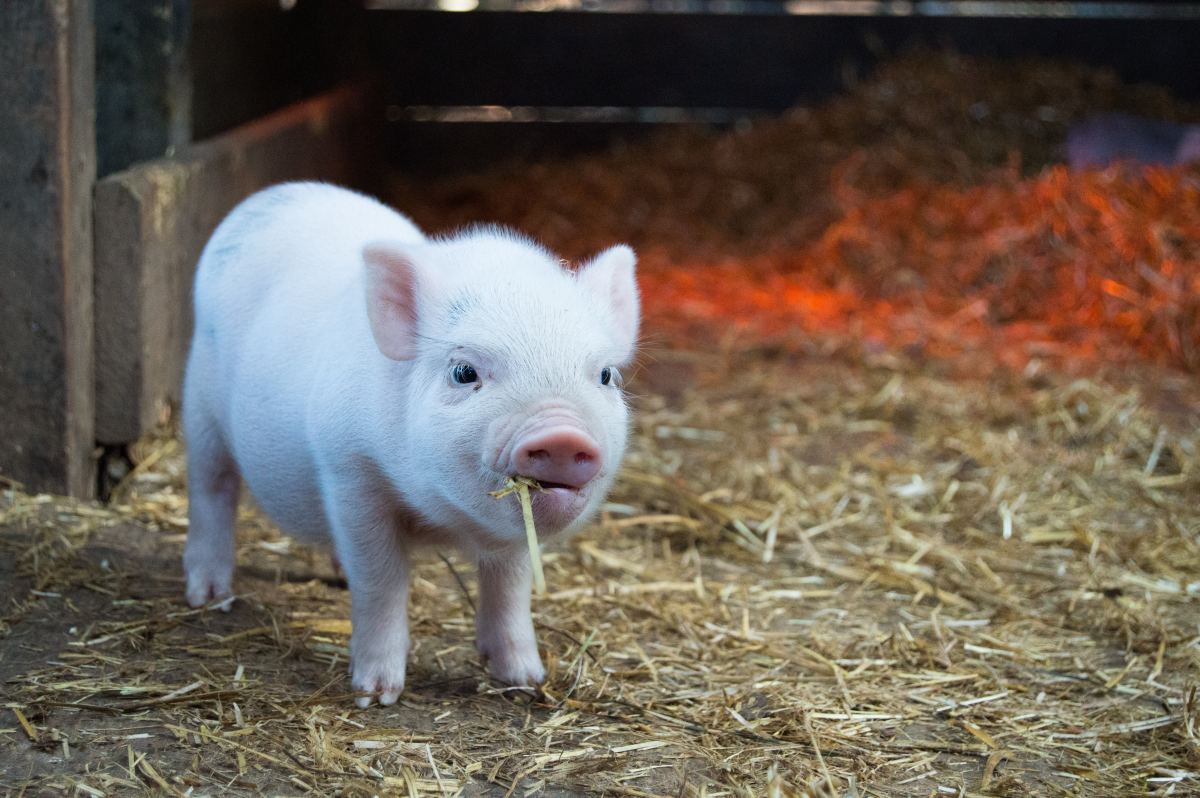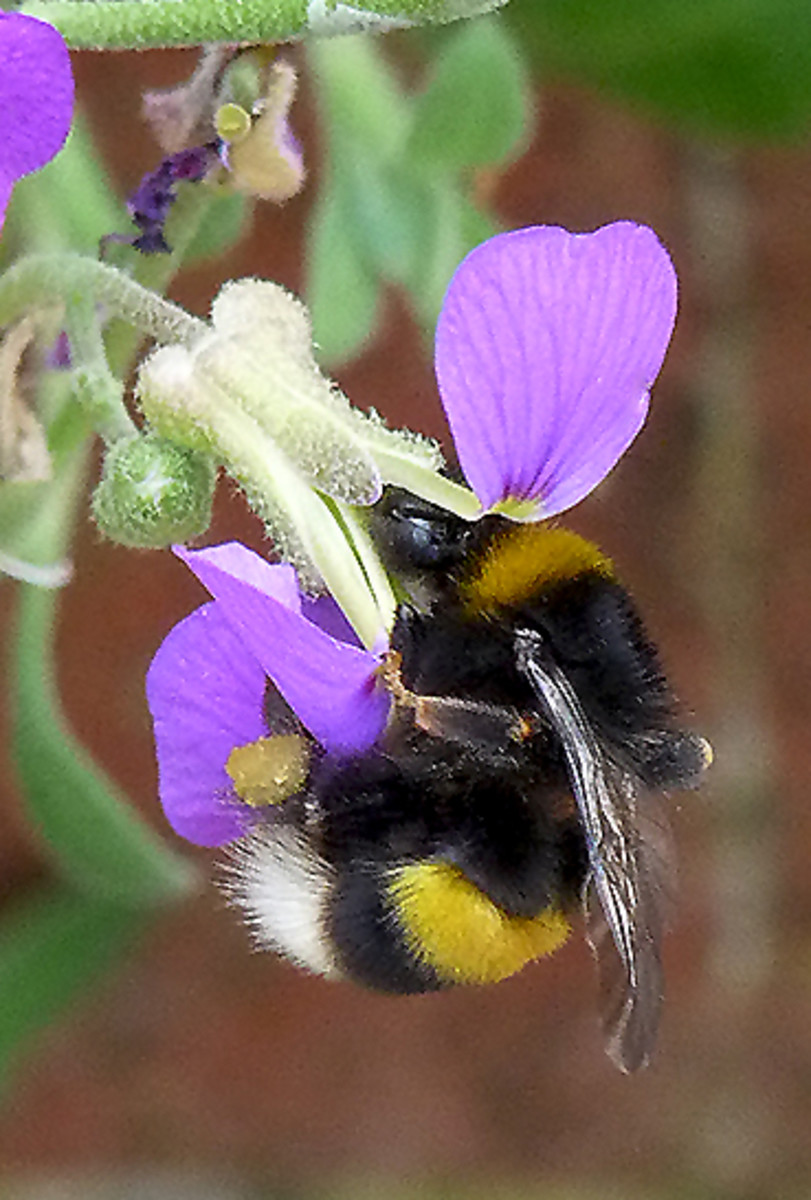Nature's Easter Eggs
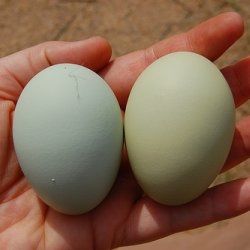
Naturally Colored Chicken Eggs
Chicken eggs come in lots of different colors, not just brown and white. I call these colored eggs, nature's Easter eggs since it seems like nature decorated them for us already. After you see a few of these colored eggs, it makes those racks of plain white supermarket eggs seem boring. Plus if you have a few of the chickens that lay these already-colored eggs you can have the fun of an Easter egg hunt every day.
Picture from observing life
Naturally Colored Eggs
Yes, all the eggs on this lens, even the brightly colored ones, are their natural color. They were not dyed to get these shades, these are the color that they were when they were laid.
Egg Colors
Though it may seem like brown and white are the only shades of eggshells, there are actually quite a few different colors that chicken eggs come in. Eggs may be all sorts shades of blue from sky to baby; green shades from pale, pale mint to olive; pink to pinkish brown; pinkish purple to dark purplish brown, lavender, and some eggs even have speckles.
Diversity Is Fun
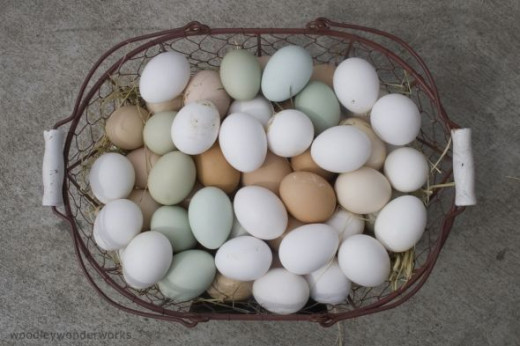
Even though the only difference in colored eggs is the shell, it's fun to collect a variety of colors from your chickens. It makes it feel like Easter every day
Nature's Easter Eggs
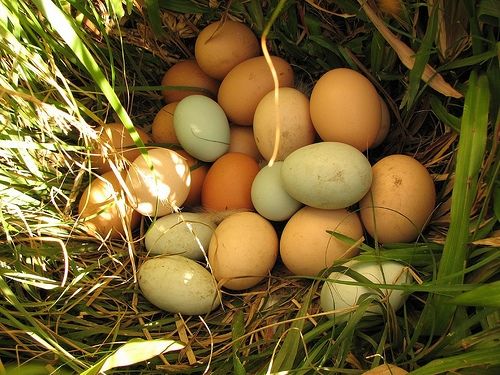
Picture via Creative Commons from robstephaustralia
Naturally-colored chicken eggs really simplify Easter, no need to dye the eggs, and some chickens will even hide them for you ;-)
Do Colored Eggs Taste Different?
This is a frequent question, and while I think it would be cool if the answer was yes, the truth is there's no difference in taste between different colored eggs. All eggs are essentially the same inside, regardless of what color their shells are. The same things go into the egg , no matter what color eggs the hen lays. The only difference in taste you might discover is that store-bought eggs, which are usually white, taste much different than farm-bought eggs, which are often various colors. This difference in taste is not due to the color of the egg's shell, it's from the difference in diets between caged, factory raised chickens versus free ranging farm chickens. Color-coded, differently-flavored eggs would be tons of fun though :)
Hunting For Eggs

Picture via Creative Commons from woodleywonderworks
These kids get to go egg hunting all the time, not just on Easter.
Various Colored Eggs
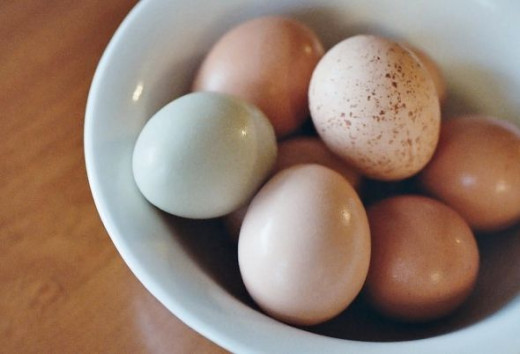
Picture via Creative Commons from thanker212
Naturally Blue and Green Eggs
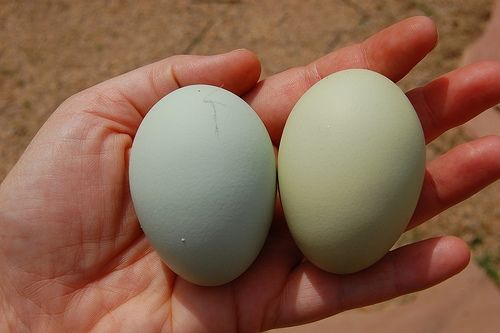
Picture via Creative Commons from observing life
Types of Chicken Eggs Video
Colorful Collection
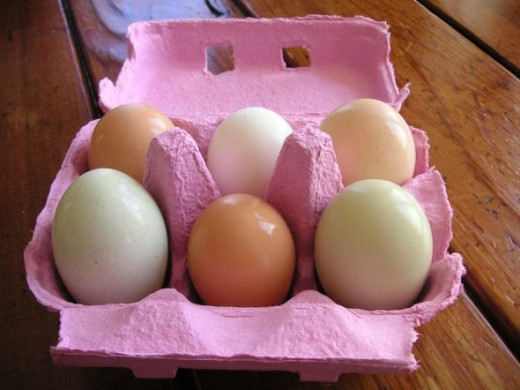
Picture via Creative Commons from blmurch
Are Brown Eggs Healthier?
Many people have thought that to be healthy, they had to buy the brown eggs at the supermarket. This is nowhere close to true, and is a waste of money if that's the only reason you buy brown eggs. All eggs are essentially the same inside, no matter what color the shell of the egg is. It's often fun to get eggs of a different color, just for something different to look at, but it in no way affects the healthiness of the eggs. The only thing that affects how healthy the eggs are is the hen and her diet. A wide variety of foods, including grass and insects, will result in delicious and healthy eggs, no matter whether they are white, blue, green, brown, or purple.

Chicken Breeds That Lay Brown Eggs
Some common and not so common chicken breeds that lay brown eggs:
*Australorps
*Barnevelders-some, really dark brown eggs
*Brahmas
*Buckeyes
*Chanteclers
*Cochins
*Cornish-light brown
*Delawares
*Dominiques
*Javas
*Jersey Giants
*Langshans-historically laid very dark, plum-colored eggs
*Marans-some lay dark, chocolately brown eggs
*Naked Necks or Turkens-very light brown eggs
*New Hampshires
*Orpingtons
*Penedesencas-very dark, red-brown eggs
*Plymouth Rocks
*Rhode Island Reds and RI Whites
*Silkies-slightly tinted with tan
*Sussex
*Welsummers-can be dark brown
*Wyandottes
Picture by modomatic
Different Color Brown Eggs
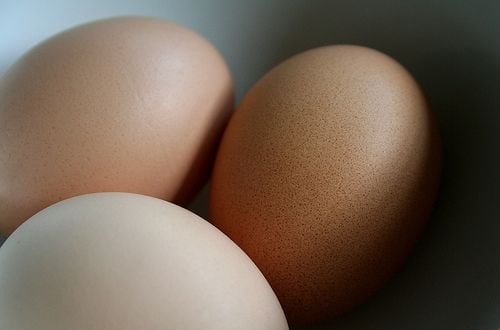
Picture from MinivanNinja
Different Chicken Eggs
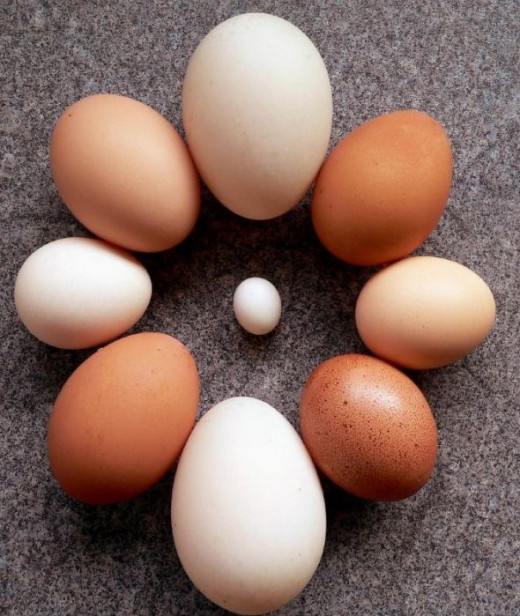
Picture via Creative Commons from robstephaustralia
Wonderful Brown Eggs
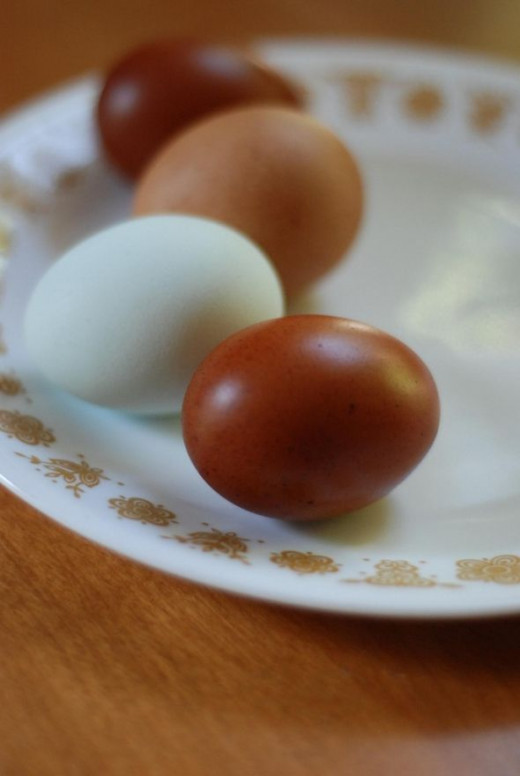
Picture via Creative Commons from .j.e.n.n.y.
Dark Brown Chicken Egg
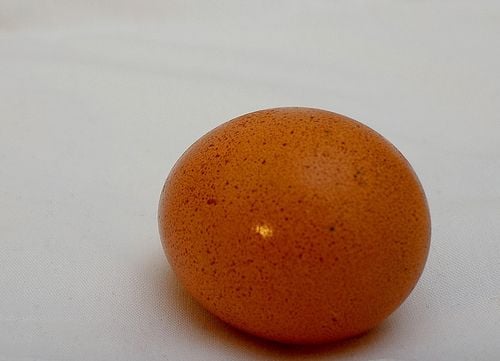
Picture from MonkeySimon
Pretty Chicken Eggs
Click thumbnail to view full-size









Living In Harmony
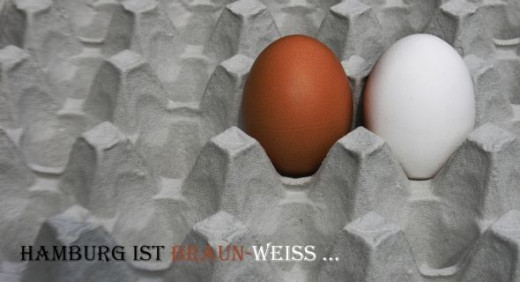
Picture via Creative Commons from Frank Jakobi
Do Brown Chickens Lay Brown Eggs?
Certain breeds lay certain color eggs. This is not related to feather color, so there can be chickens that are one color and lay a different color egg, such as the Delaware. The Delaware breed of chickens has a White Columbian feather pattern. Since it's white, most people would think it would lay a white egg. That is not the case. Delawares actually lay brown eggs, no matter what color their feathers are. The Minorca breed comes in a couple of colors, but one of the most common is black. Minorcas lay pretty white eggs.
Feather colors do not show what color eggs the chickens will lay, if that was the case there would be blue and green chickens. The best way to know what color eggs will come out of each chicken is to know what breed it is since certain breeds lay certain colors. It is also often possible to see what color egg will get laid by looking at the pullet's ear lobe, white ear lobes mean the chicken may be a breed that lays white eggs, red ear lobes mean the chicken may be a breed that lays brown eggs. This is not always true, and still leaves the blue and green egg layers out, so it's best to use it as sort of a basis for a guess.
Pink Eggs
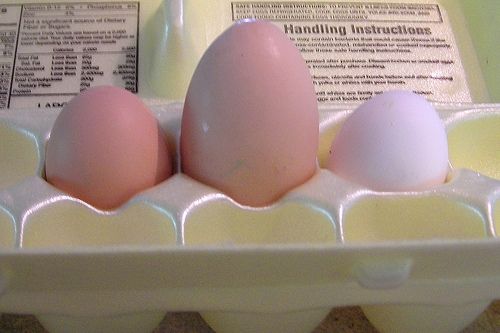
Picture via Creative Commons from normanack
Lots of Eggshell Shades
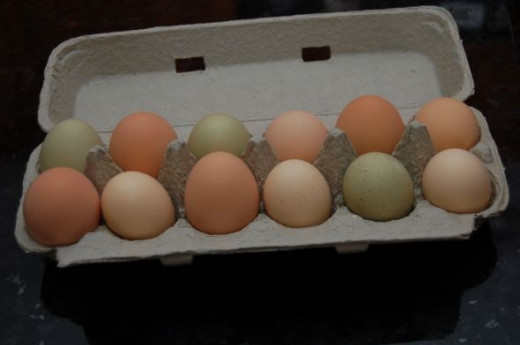
Picture via Creative Commons from observing life
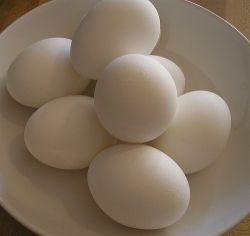
Chicken Breeds That Lay White Eggs
There are several types of chickens that lay white eggs. Not all of them are pure, snow white though, some of them are slightly tinted with brown. Chalky, creamy, pearly, and off-white are all good ways to describe some of those plain white eggs.
*Anconas
*Andalusians
*Appenzellers
*Asils
*Belgian D'Anvers
*Belgian D'Uccles
*Buttercups
*Campines
*Catalanas
*Cubalayas
*Dorkings
*Dutchs
*Faverolles
*Egyptian Fayoumis
*Hamburg
*Holland
*Houdans
*Japanese
*La Fleches
*Lakenvelders
*Leghorns
*Malays
*Minorcas
*Modern Games
*Old English Games
*Orloffs
*Phoenixes
*Polish or Polands
*Rosecombs
*Sebrights
*Spanish White-Faced Blacks
*Sultans
*Sumatrans
*Yokohamas
Picture from cursedthing
Supermarket White Eggs
If you only eat eggs from the supermarket you have most likely only eaten eggs from one chicken breed. That's because most commercial factory farms raise only one breed of chicken, the one breed that out performs all the others in a factory farm, the white leghorn. Almost every single egg eaten in this country comes from white leghorn hens. White leghorns lay hundreds of eggs a year, one almost every single day from the time they start laying, though they do taper off on laying after their first year, which is the reason poultry farms get rid of their chickens then.
Egg View
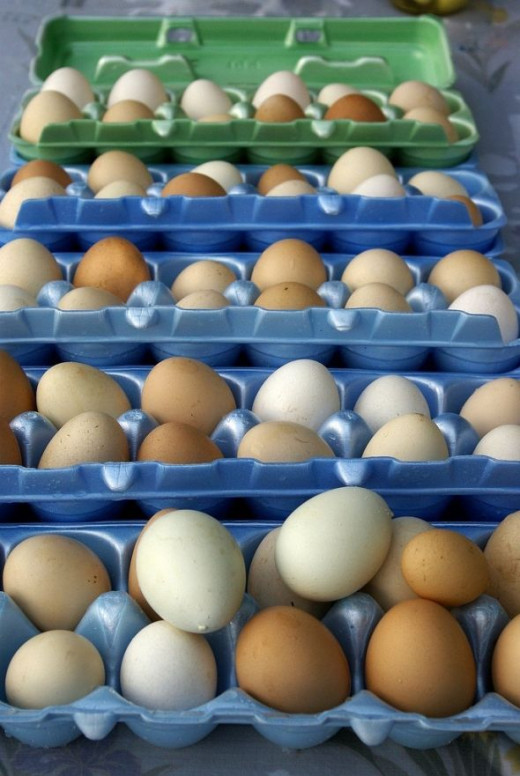
Picture via Creative Commons from House Of Sims
Eggs Come In Different Shapes and Colors
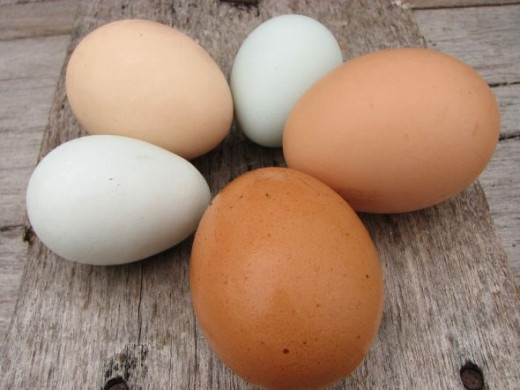
Picture via Creative Commons from robstephaustralia
Mixture of Chicken Eggs
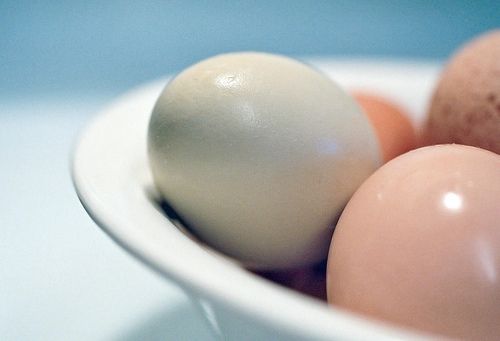
Picture from thanker212
Chickens That Lay the Golden Egg
So far, I've never seen gold egg laying chickens, but there is a big call for chicken eggs that are different from the factory-farm, bleached-looking white eggs we all see at the supermarket. Family farms are becoming popular once again, as more people realize fresh and healthy food tastes good and is healthier too. Many people, unable to raise their own chickens for eggs, try to find yummy eggs they can buy for their own families, but in some areas this is difficult to do. This, and the sudden, resurgence of popularity in the keeping of chickens, have combined to make some people, who never thought they'd do such a thing, into chicken-farmers. People raising honest and quality chicken eggs can make a bit of extra money off of a fulfilling hobby, and supply their family with fresh henfruit in the bargain. The eggs may not be golden, but blue and green will do.
Olive, Blue, Green, and Orange Eggs
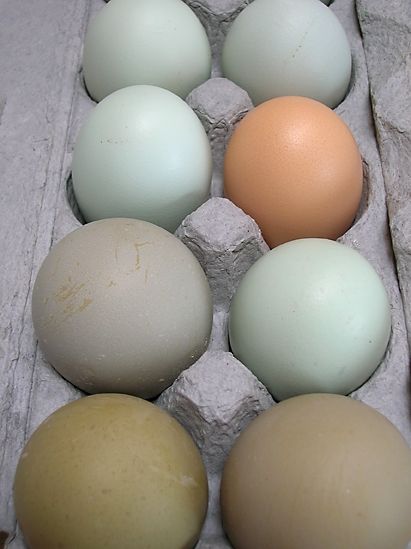
Picture via Creative Commons from Claudia Crane
Where Do Green Eggs Come From?
Green eggs are very interesting. They are actually created by a chicken with the brown egg gene to a chicken with the blue egg gene. The blue egg is created and overlaid with the brown color, so it becomes sort of green. Some of the prettiest green eggs come from a mixture of the breeds of Ameraucana and Maran.
Green Eggs and Ham
Where would we be on a colored egg lens without adding the classic, Green Eggs and Ham?

Green Eggs
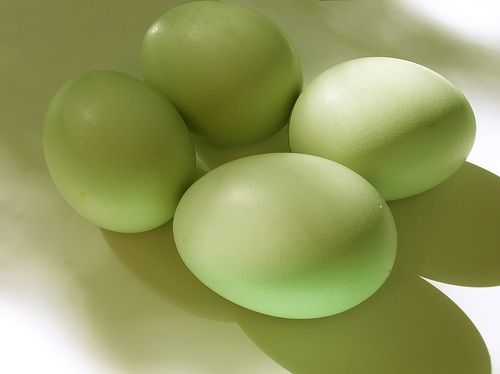
Picture via Creative Commons from Claudia Crane
Various Colored Chicken Eggs
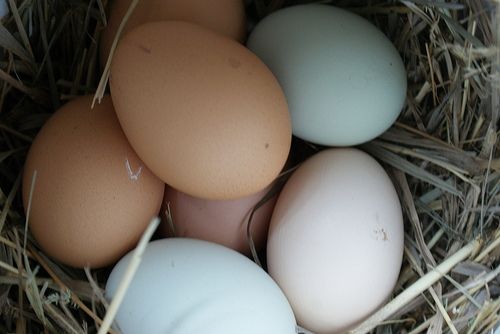
Picture from Cortney @ Dog, Farm, Canvas, Quilt Cortney Dean
Blue Chicken Eggs
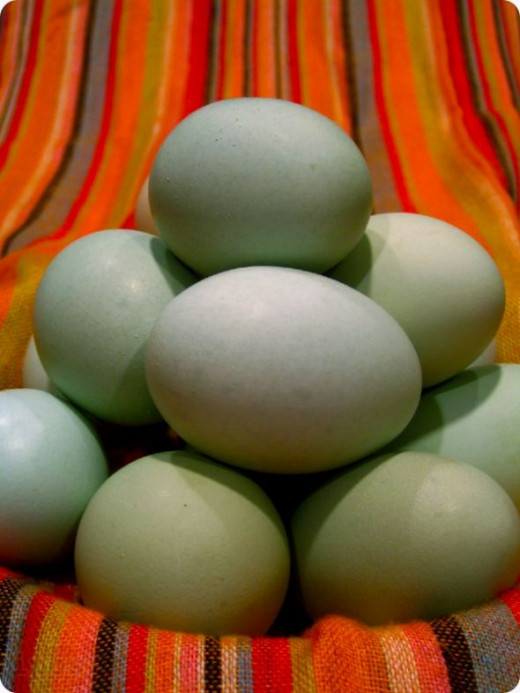
Picture via Creative Commons from In Praise of Sardines
Blue Eggshell
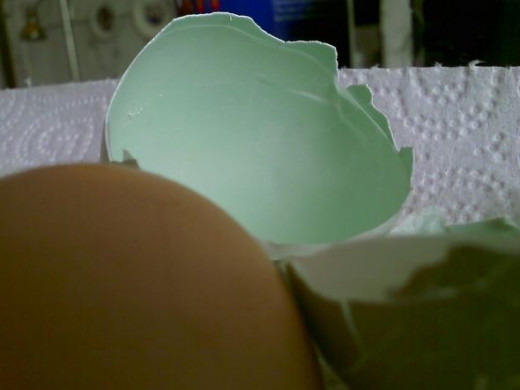
Picture via Creative Commons from Jannie-Jan
Unlike brown eggs, the color for blue eggs goes all the way through and isn't just on the surface on the shell.
Chicken Breeds That Lay Blue/Green Eggs
There are several chicken breeds that lay slightly tinted, colored eggs, but if you see blue or green eggs, there's only three types of chickens that could have come from:
Araucanas
Ameraucanas
Mixed Breed or Easter Eggers
Ameraucanas, Araucanas, Easter Eggers?
"My chickens lay blue/green eggs, does that mean I have an Araucana or Ameraucana?"
There's always a lot of confusion over the different blue or green egg-laying breeds. Some people think they've got Araucanas, when they really have Ameraucanas. Others think their Easter Eggers are Ameraucanas. It's even more confusing since many feed stores don't even know what they have, so tell people they're buying another breed. Plus, the background of each breed is confused and no one really knows their histories. Luckily for us, the poultry fanciers have come up with criteria for each of the breeds to have before they can be considered Ameraucanas or Araucanas, so we can identify the different breeds.
Araucanas are often called rumpless Araucanas since they have no tails. All they have is a sort of bump for a butt. They also have things called ear tuffs, clumps of feathers by their ears, and the chickens often have a sort of looking-down-their-beaks look. They lay only blue eggs. Araucanas are also fairly rare since they have odd genetics that make a quarter of them die in the shell. You are extremely unlikely to find true Araucanas at a feed store or chick hatchery. If you want this chicken breed, you'll need to find a real Araucana breeder. A good place to do this is a chicken show or an Araucana group.
Ameraucanas are a bit more common than Araucanas. They are becoming popular for breeders to raise since they don't have the lethal gene that Araucanas have, are recognized by the American Poultry Association (so can get shown at chicken shows), and still have pretty colored eggs. Ameraucanas have tails, lay colored-eggs, and have muffs and beards, little clumps of feathers under their chins. They lay blue eggs. Most feed stores will say they have Ameraucana chicks for sale, but they don't realize they are getting and selling mixed breeds called Easter Eggers. The best way to get quality Ameraucanas is to get them from Ameraucana breeders.
Easter Eggers are the colored-egg laying chicken that most people have. Easter Egger is basically a nice name for a mutt, or a chicken that has a mix of genetics in it. Since the genes are so dominant, they usually look a lot like Ameraucanas, but will frequently lay not-quite blue eggs and have slight feature differences such as the wrong comb shape or different colored legs. The blue egg gene is dominant, so their eggs will usually have blue in them, just aren't likely to be the perfect sky blue of Araucanas. If your chicken lays green eggs, bluish eggs, pink eggs, or other colors, they are most likely Easter Eggers. Easter Eggers can be just as wonderful as purebred Araucanas and Ameraucanas, but they do not qualify for being show chickens, nor do they always breed true. If you purchased your chickens from a feed store or chick hatchery you most likely have Easter Eggers, mixed breeds with the blue egg gene.
Easter Egger Hens
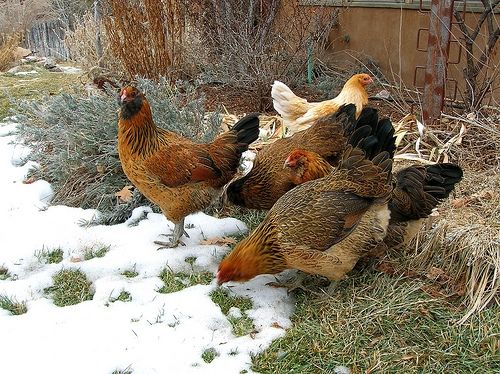
Picture via Creative Commons from Claudia Crane
Assorted Colored Chicken Eggs
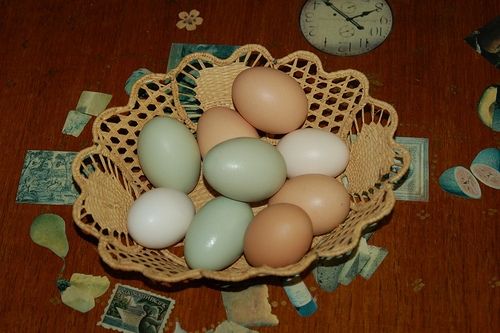
Picture from Jasmine&Roses
Araucana
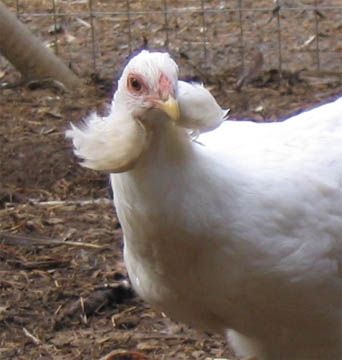
Picture via Creative Commons from sievloet
Freshly Laid Pink Eggs
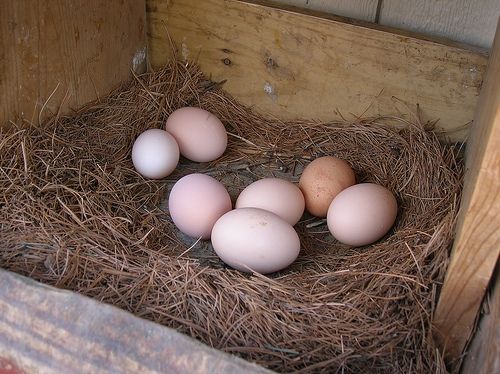
Picture via Creative Commons from Jake Wasdin
More Chicken Information
Want to learn more about chickens or even thinking about getting some yourself? (you should! :) Check out these sites for a whole lot of information.
- Backyard Chickens Site
The main section of Backyard Chickens. Find a link to Raising Chickens 101, a beginner's guide to chickens, the Learning Center, and the forum. - Backyard Chickens Forum
Go on, go hang with your peeps at the ultimate chicken forum. Chat about chickens, ask questions, find like-minded people nearby. The forum has information on just about everything, and what they don't have a post on you can ask some of the friendly - The Classroom at the Coop
Lots of information on this forum as well. Plus, there's some members with great information on genetics. - The Chickens101 Yahoo Group
This group is all about chickens. Talking about them, learning about them, even just being with other chicken enthusiasts.
Blue and Brown Eggs
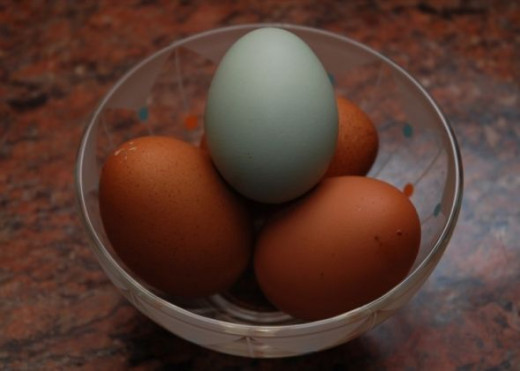
Picture via Creative Commons from Julian Berry
What Makes Different Color Eggs?
Every chicken lays a slightly different color egg and experienced chicken raisers can often tell which of their chickens laid which egg by the shade, different bumps, and size of the eggs. There is some variation over time as well. New hens, when they just start laying will often have uneven patterns and odd sized eggs, then the color and shape and size will usually even out as she starts laying regularly. When the chicken starts reaching the end of her egg production time or gets stressed, she may lay odd eggs again.
Eggs are colored by the different pigments applied to the shell as they pass through the hen's system. Each type of chicken has evolved through natural or artificial breeding to lay certain color eggs. Each hen of each breed has a different color scheme inside of her which depends on her genetics, and so she will lay certain color eggs according to her breeding. The genetics of egg coloring are very complex and we still don't understand everything about them, so unless the hen is purebred we do not always know what color egg she will lay and even if she is purebred we may not always know the exact shade of color she will lay.
A Rainbow Dozen
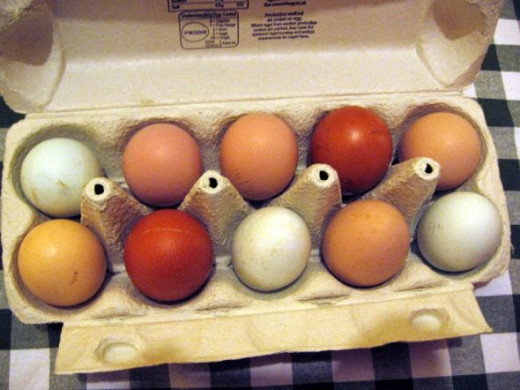
Picture via Creative Commons from pshab
Learn More About Chickens
Thinking about getting some chickens or just want to know some more about them? Check out these books. They're full of great information and will fill you in on all the details.
Nest with Eggs
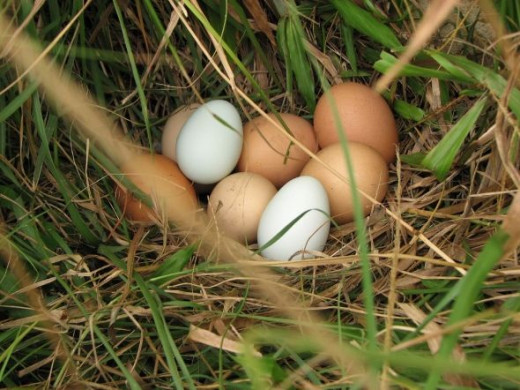
Picture via Creative Commons from robstephaustralia
Search More Chicken Eggs
Share your eggs-periences with eggs and give us your opinion on the best colored eggs by leaving a comment. Thanks!

